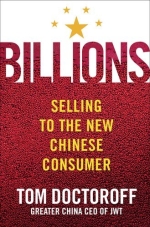JWT Defines China's 'Confusion Consumer,' Definitions Questioned

Coinciding with the launch of China CEO Tom Doctroff's book, Billions: Selling the the New Chinese Consumer, JWT China issued a press release with the headline, "Understanding and Embracing China's Different Worldview Is Main Theme of Billions: Selling to the New Chinese Consumer, by JWT's Tom Doctoroff," which offers 12 facts about the "Confucian Consumer." While the release may seem like yet another harmless attempt by a marketing entity to neatly lump together the traits of billions of people and slap a cute title on it, some who watch the country's culture closer have taken issue with the oversimplification and incorrectness of the 12 facts.
The main complaint is the trotting out of Confucius to "frame the market for American business people" writes the China Herald weblog that doing so "creates the illusion that there is one driving force in the Chinese market you can use as a beacon in an often chaotic situation." In an article on Danwei written by Jeremy Goldkorn who works in the Chinese ad biz, he offers a a point by point analysis of the release and ends with "bullshitting is part of the game in the advertising industry." While we have no idea who's right and who's wrong on this whole Confucian Consumer thing nor are we equipped to make judgement, we do know Goldkorn's statement is as true as the Earth is round.


Comments
From my experience of living and working in China since 2000, I can verify that there is one concept is very true: cutting expenses in the home to purchase more the outwardly display of status symbols. Most of the other points are poorly researched conjecture from a foreigner trying to make a quick buck on a China play.
Pizza here may be topped with fish, red chilis, squid or even corn, though none of my chinese friends like pineapple.
I haven't read the book, so I can't guess how he built this premise, but 'fresh' does not mean alive in Mandarin - it means fresh. A glaring error like this definitely puts the rest of the 'research' into question.
Most Chinese still don't commonly say "I love you" - even as a parent to their child, so the logic here is somewhat flawed. Though the underlying premise of concrete demonstrations of committment is correct and loosely ties in with displays of wealth.
The main point to take away here is that:
1. Market insight into this region is sorely needed for foreign companies to make sense of the culture in relation to their products.
2. Chinese culture (and their consumer habits) differs greatly by region and anyone who has a cookie cutter solution for the China consumer is either a true global visionary or, more likely, just full of s**t.
3. Publishing results like this just illustrates the significant lack of understanding of the Chinese comsumer by foreign markets.
As a marketing professional coming from China, I applaud Tom Doctoroff’s efforts in trying to understand the Chinese consumer. No doubt he has contributed greatly to the development of Chinese consumer insights, but I have to respectfully disagree with him on most of his findings.
I validate all of the Mark Warholak’s comments. My family eats pizza, but does not like the Pineapple on top, the only person who eats it is my teenage niece because she thought that was authentic American.
Not true that Chinese people never have dinner parties. Chinese people do hold dinner parties, they may not be the same type of parties one so accustomed to seeing in the U.S. or other western countries, but there are social gatherings at home, over dinner and drinks. The parties are normally smaller in size relative to the western standard due to the limited space in Chinese homes, but they are parties definitely.
The twelve facts are facts only to a certain degree; it would be a big mistake if one believes that this represents the Chinese people as consumers. There is much more to argue about or to discuss with Tom about the twelve facts, but the bottom line is that international marketing firms in China need to really get down from the high tower buildings, not just physically but mentally, and immerse into the crowd of Chinese consumers, like P&G is doing. There is much more work to be done before true pictures of Chinese Consumer can be unveiled and before the consumer insights can be effective as a marketing tool.